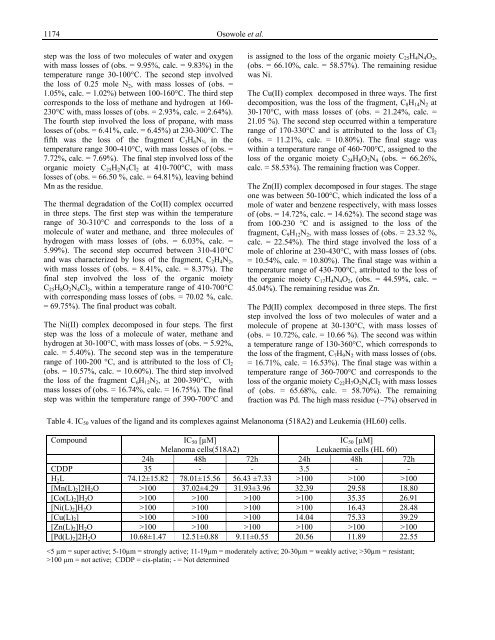Download (5Mb) - Covenant University Repository
Download (5Mb) - Covenant University Repository
Download (5Mb) - Covenant University Repository
You also want an ePaper? Increase the reach of your titles
YUMPU automatically turns print PDFs into web optimized ePapers that Google loves.
1174<br />
step was the loss of two molecules of water and oxygen<br />
with mass losses of (obs. = 9.95%, calc. = 9.83%) in the<br />
temperature range 30-100°C. The second step involved<br />
the loss of 0.25 mole N2, with mass losses of (obs. =<br />
1.05%, calc. = 1.02%) between 100-160°C. The third step<br />
corresponds to the loss of methane and hydrogen at 160-<br />
230°C with, mass losses of (obs. = 2.93%, calc. = 2.64%).<br />
The fourth step involved the loss of propane, with mass<br />
losses of (obs. = 6.41%, calc. = 6.45%) at 230-300°C. The<br />
fifth was the loss of the fragment C3H6N¾ in the<br />
temperature range 300-410°C, with mass losses of (obs. =<br />
7.72%, calc. = 7.69%). The final step involved loss of the<br />
organic moiety C25H2N5Cl2 at 410-700°C, with mass<br />
losses of (obs. = 66.50 %, calc. = 64.81%), leaving behind<br />
Mn as the residue.<br />
The thermal degradation of the Co(II) complex occurred<br />
in three steps. The first step was within the temperature<br />
range of 30-310°C and corresponds to the loss of a<br />
molecule of water and methane, and three molecules of<br />
hydrogen with mass losses of (obs. = 6.03%, calc. =<br />
5.99%). The second step occurred between 310-410°C<br />
and was characterized by loss of the fragment, C2H4N2,<br />
with mass losses of (obs. = 8.41%, calc. = 8.37%). The<br />
final step involved the loss of the organic moiety<br />
C25H8O2N4Cl2, within a temperature range of 410-700°C<br />
with corresponding mass losses of (obs. = 70.02 %, calc.<br />
= 69.75%). The final product was cobalt.<br />
The Ni(II) complex decomposed in four steps. The first<br />
step was the loss of a molecule of water, methane and<br />
hydrogen at 30-100°C, with mass losses of (obs. = 5.92%,<br />
calc. = 5.40%). The second step was in the temperature<br />
range of 100-200 °C, and is attributed to the loss of Cl2<br />
(obs. = 10.57%, calc. = 10.60%). The third step involved<br />
the loss of the fragment C6H12N2, at 200-390°C, with<br />
mass losses of (obs. = 16.74%, calc. = 16.75%). The final<br />
step was within the temperature range of 390-700°C and<br />
Osowole et al.<br />
is assigned to the loss of the organic moiety C25H4N4O2,<br />
(obs. = 66.10%, calc. = 58.57%). The remaining residue<br />
was Ni.<br />
The Cu(II) complex decomposed in three ways. The first<br />
decomposition, was the loss of the fragment, C8H14N2 at<br />
30-170°C, with mass losses of (obs. = 21.24%, calc. =<br />
21.05 %). The second step occurred within a temperature<br />
range of 170-330°C and is attributed to the loss of Cl2<br />
(obs. = 11.21%, calc. = 10.80%). The final stage was<br />
within a temperature range of 460-700°C, assigned to the<br />
loss of the organic moiety C24H8O2N4 (obs. = 66.26%,<br />
calc. = 58.53%). The remaining fraction was Copper.<br />
The Zn(II) complex decomposed in four stages. The stage<br />
one was between 50-100°C, which indicated the loss of a<br />
mole of water and benzene respectively, with mass losses<br />
of (obs. = 14.72%, calc. = 14.62%). The second stage was<br />
from 100-230 °C and is assigned to the loss of the<br />
fragment, C9H12N2, with mass losses of (obs. = 23.32 %,<br />
calc. = 22.54%). The third stage involved the loss of a<br />
mole of chlorine at 230-430°C, with mass losses of (obs.<br />
= 10.54%, calc. = 10.80%). The final stage was within a<br />
temperature range of 430-700°C, attributed to the loss of<br />
the organic moiety C17H4N4O2, (obs. = 44.59%, calc. =<br />
45.04%). The remaining residue was Zn.<br />
The Pd(II) complex decomposed in three steps. The first<br />
step involved the loss of two molecules of water and a<br />
molecule of propene at 30-130°C, with mass losses of<br />
(obs. = 10.72%, calc. = 10.66 %). The second was within<br />
a temperature range of 130-360°C, which corresponds to<br />
the loss of the fragment, C7H9N2 with mass losses of (obs.<br />
= 16.71%, calc. = 16.53%). The final stage was within a<br />
temperature range of 360-700°C and corresponds to the<br />
loss of the organic moiety C22H7O2N4Cl2 with mass losses<br />
of (obs. = 65.68%, calc. = 58.70%). The remaining<br />
fraction was Pd. The high mass residue (~7%) observed in<br />
Table 4. IC50 values of the ligand and its complexes against Melanonoma (518A2) and Leukemia (HL60) cells.<br />
Compound IC50 [µM]<br />
Melanoma cells(518A2)<br />
IC50 [µM]<br />
Leukaemia cells (HL 60)<br />
24h 48h 72h 24h 48h 72h<br />
CDDP 35 - - 3.5 - -<br />
H2L 74.12±15.82 78.01±15.56 56.43 ±7.33 >100 >100 >100<br />
[Mn(L)2]2H2O >100 37.02±4.29 31.93±3.96 32.39 29.58 18.80<br />
[Co(L)2]H2O >100 >100 >100 >100 35.35 26.91<br />
[Ni(L)2]H2O >100 >100 >100 >100 16.43 28.48<br />
[Cu(L)2] >100 >100 >100 14.04 75.33 39.29<br />
[Zn(L)2]H2O >100 >100 >100 >100 >100 >100<br />
[Pd(L)2]2H2O 10.68±1.47 12.51±0.88 9.11±0.55 20.56 11.89 22.55<br />
30µm = resistant;<br />
>100 µm = not active; CDDP = cis-platin; - = Not determined

















